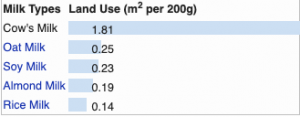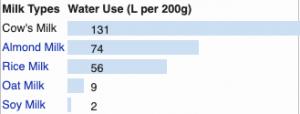The first food that I saw from my list that I had been eating was plain yogurt. The first ingredient (one of just two) is pasteurized skim milk. The website of this brand, Siggi’s, wrote that the milk that they use comes from “family farms” in upstate New York and Wisconsin. The largest global exporter of milk, however, is New Zealand, but the U.S. is also a top worldwide producer. I was surprised to learn that in 2016, there was a worldwide excess of milk and governments began to decrease the overproduction. The most common practices of milk production in the US are automated milking from Holstein cows who spend their lives in industrial ‘farms’. Pasteurization is a process that reduces bacterial growth and extends shelf life of milk and is now widely used in many parts of the world. This development has changed the production of milk because it allows for milk to be shipped all over the country and reduces the need for fresh, local milk. For the production of milk, there are vast chemical and mechanical resources required for the industrial process. There are also great environmental resources needed for milk production, such as land and water and it’s production involves a staggering amount of greenhouse gas emissions, water and air pollution. Some dated approximations show the dairy industry as contributing to around 4% of total greenhouse gas emissions. There are various social impacts of the dairy industry, one being how the industrial and multi-national dairy companies have destroyed smaller farms and absorbed mid-size dairy operations and so have cut out more traditional forms of producing milk. Assuming the milk is coming from somewhere in the Midwest United States, the average food miles could be 1000 miles.
Interestingly, I drink another form of ‘milk’ everyday with coffee and the first ingredient in this plant milk is pea protein. It was challenging to find information on this ingredient because it is a newer alternative (the company was founded in 2014 and is awaiting a patent on their technology). The protein is extracted from yellow peas and added to many kinds of foods like energy bars, ice cream and veggie burgers. Peas are grown in colder climates worldwide, however Canada has 51% of the export market. More than 75% of US peas are exported to India, China and Spain for processing. Assuming the peas in this plant milk are coming from Canada, the food miles on this ingredient could be around 3,300 miles!
Below are some graphics comparing the various different kinds of dairy and plant-based milks and their environmental footprint in resources such as land and water. It appears that pea protein milk has the lowest water footprint and cow’s milk has the highest land/water use compared to all alternatives. This encourages me to consider the environmental impact of all dairy products, not only milk, and to be active in comparing the various impact of plant alternatives as well.
flour can have food miles totaling up to 6,926 miles.



One other food that I have been eating recently are bagels! The first ingredient listed for the brand I buy is organic wheat flour. China by far produces the most wheat out of any country in the world, however the U.S. and Russia are the top two exporters of wheat. Wheat is a valuable ingredient in many foods and has become one of the most-consumed foods in our diets. Wheat, as well as corn, is used in the making of processed foods and has radically altered diets and food systems around the world. The incredible increase in wheat production is due to synthetic nitrogen fertilizer introduced in the mid twentieth century, irrigation and genetically modifying crops for increased yield. Refined wheat flour is made from only certain parts of the kernel and many of the vitamins and nutrients are stripped away and often the product is chemically bleached. Assuming that the wheat is grown in China, flour can have food miles totaling up to 6,926 miles.
Leave a Reply